|
|
|
|
 Print Print
|
|
|
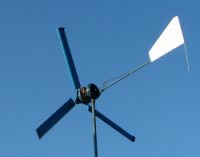
|
| Understanding swept area. |
|
Swept area of a HAWT wind turbine is basically the area swept by the turbine blades. Blade mounts and the hub are generally not included in swept area, as these parts of the turbine are not making any power. So how do we work out swept area and how important are different parts of the swept area.
To work out the area of a circle we use...
 or 3.14 x r x r or 3.14 x r x r
When we apply this formula to circles of various sizes, we see that larger circles have a much much larger area. A 100mm diameter circle has 4 times the area of a 50mm circle.
If we break a circle into even sections along its radius, and work out the area's of the sections, you can see the outer part of a circle has the most area.
If we apply this same formula to a wind turbine, its quickly obvious the outer part of a turbine is where most power is made.
The inner part of the turbine is where the blade bending, gyroscopic and twisting forces are at their highest, most blades break near the hub or centre of the turbine. However this part of the turbine returns the least amount of power from the wind.
So how much power is generated by the inner part of a turbine? |
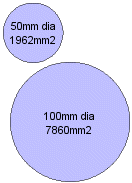
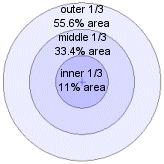
|
Lets look at some real life examples. The windmill to the right has a 2.5m diameter turbine. The hub is 0.3m ( 300 mm ) in diameter, and the blades are 1.1m long each. The total area is 3.14 x 1.25m x 1.25m = 4.9m2.
Next we take away the area of the hub, since its not making any power for us. Its area is 3.14 x 0.15 x 0.15 = 0.07m2, about 1.4% of our total area. Once we take this area away from our total area, we end up with a swept area of 4.83m2. |
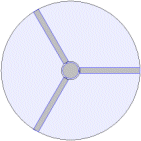 |
So we're not loosing much power with our 300mm diameter hub. What if we take a little more out from the centre. Say we add another 150mm to our hub radius, the blades don't start until 300mm out from centre. Remember the total area was 4.9m2. We take out the new area of 3.14 x 0.3m x 0.3m = 0.28m2, leaving us with a swept area of 4.62m2. This great big 600mm diameter hole in the middle of our turbine is only loosing us 5.7% of our total area, or 4.3% more than our original hub. What's more, our blades are now only 0.95m long. |
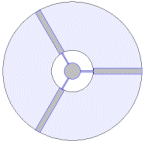 |
Another example. this turbine was made with 1m blades, on a 300mm hub. It has a total diameter of 2.3m, total area of 4.15m2. We loose 0.07m2 in the hub, so end up with a swept area of 4.08m2.
This time, we'll move the blades out by 150mm. |
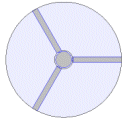 |
Our new diameter is 2.6m, giving us a total area of 5.3m2. Big improvement over our original 4.15m2, but how much did we loose in the middle?
The "hole in the middle" is now 600mm diameter, or 0.28m2. Take that away from our new total area gives us a swept area of 5.02m2
So my moving our blades 150mm further out, we gained almost 1m2 in swept area, about 19% increase. |
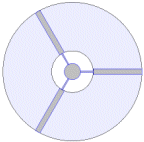 |
However, its worth noting a increased diameter, while giving more power, will mean the turbine will run at a lower RPM. Therefore you will need slightly more wind to achieve the same cut in speed, unless you make changes to your alternator to make better use of low RPM power.
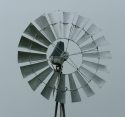 An farm windmill only has blades on the outer part of the turbine. The inner part is left open to make the turbine easier to maintain and has more strength with cross braces. An farm windmill only has blades on the outer part of the turbine. The inner part is left open to make the turbine easier to maintain and has more strength with cross braces.
So what can we conclude from all this. Well, the inner part of a turbine will give us the least amount of power from our turbine. However the inner part of our turbine is the most stressed part, and if you are calving your own timber blades, is the most difficult part to make. So its better to loose a 100mm or so from the inner part of the blade in exchange for a easier to make and stronger turbine. Don't be afraid to move you blades further out from the centre.
Cosmetically, its a personal preference. Blades that finish at the turbine hub look better that blades on extensions. Same with nose cones, while they would give no real increase in power, they do make a windmill look better.
|
|
|
|
|
|
© TheBackShed 2011
|








 An farm windmill only has blades on the outer part of the turbine. The inner part is left open to make the turbine easier to maintain and has more strength with cross braces.
An farm windmill only has blades on the outer part of the turbine. The inner part is left open to make the turbine easier to maintain and has more strength with cross braces.